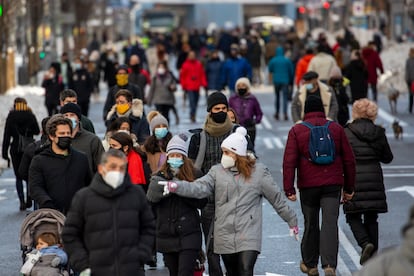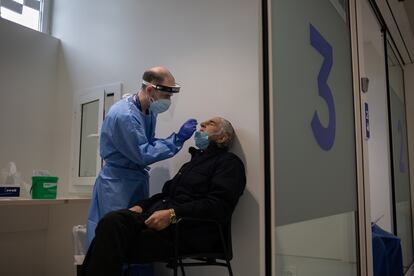Spain’s coronavirus incidence rate falls to lowest point since August 2020
The 14-day cumulative number of cases per 100,000 inhabitants has dropped to 175.3, but health authorities warn the speed of the descent is slowing

The Health Ministry’s latest report on the ongoing coronavirus crisis, which was released on Monday evening, shows that the 14-day cumulative number of coronavirus cases per 100,000 inhabitants has fallen to 175.63. This is the lowest figure seen so far this year, and is also below the minimum that the data indicator reached between the second wave of the health crisis in the autumn, and the third wave that began in December and is currently ending. This incidence level was last seen on August 21, which was when the second wave was on the rise on the back of the summer vacation season.
“Things are moving in the direction that interests us,” said Fernando Simón, the director of the Health Ministry’s Coordination Center for Health Alerts (CCAES), when presenting the data on Monday. He warned, however, that the fall in the figures, which “is going very fast,” is beginning to lose pace.
Extremadura has the lowest incidence rate followed by the Balearic Islands, La Rioja and Murcia
A month ago the 14-day cumulative number of coronavirus cases per 100,000 inhabitants in Spain was as high as 865.67, very close to the all-time high of 899.93 that was seen on January 27. The Health Ministry reported 15,978 new coronavirus cases on Monday, accounting for those detected on Friday, Saturday and Sunday, as figures are not released over the weekend. This is down from last Monday’s figure of 20,849.
The CCAES director, who as always called for caution, would not be drawn on how the data point would evolve in the future, and would only go so far as to say that he expected the incidence to continue to fall over the coming three or four days.
For now, the descent is clear to see in the data, with a drop of 30.36% in a week. But the speed of the fall has slowed since February 18, when it had gone down by 40.62% in seven days. This is logical given that maintaining the same rate is very difficult when there are fewer and fewer cases (in general, in all sequential processes it is easier to go from 100 to 50 than from 50 to 25). But this change would also be the first step for a possible shift in trend that could see the incidence rate grow once more.

Of the 19 Spanish territories that supply data to the central Health Ministry (17 regions and the North African exclave cities of Ceuta and Melilla), the lowest incidence is currently in Extremadura, with 56.01, followed by the Balearic Islands (81.52), La Rioja (82.39) and Murcia (98.27). These are the only areas that are currently below 100. On the opposite scale is Melilla (367.69), Madrid (284.58) and Ceuta (264.22). The three territories are the only ones that remain above the 250-mark considered by the Health Ministry to be extreme risk.
While the figures are still low compared to one month ago, it should be pointed out that on June 20, at the end of the first wave, this parameter was at 7.9 on a national level. Madrid, which was the region with the worst data at the time, was at 18.08. Thanks to these low figures, the second wave grew much slower and took four-and-a-half months to peak (with a 14-day cumulative number of coronavirus cases per 100,000 inhabitants of 529.43 on November 9), which allowed for an adapted response. The third wave began from a much higher level (188.72 on December 10), and in barely six weeks reached nearly 900, which brought with it a high level of stress on the country’s hospitals.
In Monday’s report, 467 Covid-related fatalities were added to this total, which now stands at 69,609
This is why Fernando Simón is still insisting that the current restrictions that have been put in place by the regions – who are in charge of managing the response to the pandemic as well as their own healthcare systems – should remain in place to keep pushing down this indicator rather than relaxing them, as some regional governments are already doing.
The government’s chief epidemiologist also pointed to the fact that the country’s intensive care units (ICUs) have a 28.09% occupation rate in terms of Covid-19 patients, meaning that any new spike could once again lead to hospitals becoming overwhelmed. Hospitalizations for Covid-19 currently account for 9.36% of the total.
As for fatalities, the official death toll now stands at 69,609. In Monday’s report, 467 Covid-related fatalities were added to this total, accounting for those reported on Friday, Saturday and Sunday. This is the lowest figure for a Monday to be reported since January 18.
English version by Simon Hunter.
Tu suscripción se está usando en otro dispositivo
¿Quieres añadir otro usuario a tu suscripción?
Si continúas leyendo en este dispositivo, no se podrá leer en el otro.
FlechaTu suscripción se está usando en otro dispositivo y solo puedes acceder a EL PAÍS desde un dispositivo a la vez.
Si quieres compartir tu cuenta, cambia tu suscripción a la modalidad Premium, así podrás añadir otro usuario. Cada uno accederá con su propia cuenta de email, lo que os permitirá personalizar vuestra experiencia en EL PAÍS.
¿Tienes una suscripción de empresa? Accede aquí para contratar más cuentas.
En el caso de no saber quién está usando tu cuenta, te recomendamos cambiar tu contraseña aquí.
Si decides continuar compartiendo tu cuenta, este mensaje se mostrará en tu dispositivo y en el de la otra persona que está usando tu cuenta de forma indefinida, afectando a tu experiencia de lectura. Puedes consultar aquí los términos y condiciones de la suscripción digital.
More information
Últimas noticias
Trump claims peace in Ukraine is near, but Moscow suggests otherwise
A survivor’s account of the Interoceanic Train accident: ‘We were scared because of the speed on the curve’
The Interoceanic Train, the Mexican alternative to the Panama Canal
What is known about the Interoceanic Train derailment in Oaxaca
Most viewed
- Oona Chaplin: ‘I told James Cameron that I was living in a treehouse and starting a permaculture project with a friend’
- Reinhard Genzel, Nobel laureate in physics: ‘One-minute videos will never give you the truth’
- Why the price of coffee has skyrocketed: from Brazilian plantations to specialty coffee houses
- Pablo Escobar’s hippos: A serious environmental problem, 40 years on
- Chevy Chase, the beloved comedian who was a monster off camera: ‘Not everyone hated him, just the people who’ve worked with him’









































